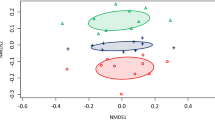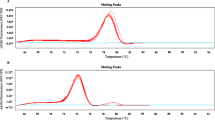Abstract
Propidium monoazide can limit the analysis of microbial communities derived from genetic fingerprints to viable cells with intact cell membranes. However, PMA treatment cannot completely suppress polymerase chain reaction (PCR) amplification when the targeted gene is too short. PMA treatment in combination with two-step nested PCR was designed to overcome this problem. Four experiments were performed to determine the limitation of PMA treatment and to evaluate the suitability of the method by applying the following samples: (1) pure cultures of Escherichia coli O157:H7, Enterobacter aerogenes, and Alcaligenes faecalis; (2) pond water samples spiked with heat-killed E. coli O157:H7 and E. aerogenes; (3) anaerobic sludge samples exposed to increasing heat stress; and (4) selected natural samples of estuarine sediment and lake mud. Results from the first two experiments show that PMA treatment cannot efficiently suppress dead cells from PCR amplification when the targeted gene is as short as 190 bp, however, the two-step nested PCR can overcome this problem. The last two experiments indicate the method that PMA treatment in combination with two-step nested PCR is useful for viable cells detection in microbial ecology.




Similar content being viewed by others
References
Bakker DP, Postmus BR, Busscher HJ, Mei HC (2004) Bacterial strains isolated from different niches can exhibit different patterns of adhesion to substrata. Appl Environ Microbiol 70:3758–3760
Dar SA, Kuenen G, Muyzer G (2005) Nested PCR-Denaturing gradient gel electrophoresis approach to determine the diversity of sulfate-reducing bacteria in complex microbial communities. Appl Environ Microbiol 71(5):2325–2330
Feng JJ, Kim JY, Liu XL, Schaad NW, Li JQ (2008) Differentiation of live and dead cells of bacteria plant pathogen in polymerase chain reaction assays using a DNA binding dye. Chem J Chinese Universities 29:944–948
Frank JA, Reich CI, Sharma S, Weisbaum JS, Wilson BA, Olsen GJ (2008) Critical evaluation of two primers commonly used for amplification of bacterial 16S rRNA genes. Appl Environ Microbiol 74(8):2461–2470
Gedalanga PB, Olson BH (2009) Development of a quantitative PCR method to differentiate between viable and nonviable bacteria in environmental water samples. Appl Microbial Biotechnol 82:587–596
Josephson KL, Gerba CP, Pepper IL (1993) Polymerase chain reaction detection of nonviable bacterial pathogens. Appl Environ Microbiol 59:3512–3515
Lee JL, Levin RE (2007) Quantification of total viable bacteria on fish fillets by using ethidium bromide monoazide real-time polymerase chain reaction. Intern J Food Microbiol 118:312–317
Lee JL, Levin RE (2009) A comparative study of the ability of EMA and PMA to distinguish viable from heat killed mixed bacteria flora from fish fillets. J Microbial Meth 76:93–96
Moan J, Peak MJ (1989) Effects of UV radiation on cells. J Photochem Photobiol B Biol 4:21–34
Mühling M, Woolven-Allen J, Murrell JC, Joint I (2008) Improved group-specific PCR primers for denaturing gradient gel electrophoresis analysis of the genetic diversity of complex microbial communities. ISME J 2:379–392
Muyzer G, Dewaal EC, Uitterlinden AG (1993) Profiling of complex microbial populations by denaturing gradient gel electrophoresis analysis of polymerase chain reaction-amplified genes coding for 16S rRNA. Appl Environ Microbiol 59(3):695–700
Muyzer G, Brikhoff T, Nübel U, Santegoeds C, Schäfer H, Waver C (1998) Denaturing gradient gel electrophoresis (DGGE) in microbial ecology. In: Akkermans ADL, van Elsas JD, de Bruijn FJ (eds) Molucular microbial ecology manual. Kluwer Academic Publishers, Dordrecht, The Netherlands, pp 1–27
Nocker A, Camper AK (2006) Selective removal of DNA from dead cells of mixed bacterial communities by use of ethidium monoazide. Appl Environ Microbiol 72(3):1997–2004
Nocker A, Camper A (2009) Novel approaches toward preferential detection of viable cells using nucleic acid amplification techniques. FEMS Microbial Lett 291:137–142
Nocker A, Cheung CY, Camper AK (2006) Comparison of propidium monoazide with ethidium monoazide for differentiation of live vs. dead bacteria by selective removal of DNA from dead cells. J Microbial Meth 67:310–320
Nocker A, Sossa KE, Camper AK (2007a) Molecular monitoring of disinfection efficacy using propidium monoazide in combination with quantitative PCR. J Microbial Meth 70:252–260
Nocker A, Sossa-Fernandez P, Burr MD, Camper AK (2007b) Use of Propidium monoazide for live/dead distinction in microbial ecology. Appl Environ Microbiol 73(16):5111–5117
Pan Y, Breidt F (2007) Enumeration of viable Listeria monocytogenes cells by real-time PCR with propidium monoazide and ethidium monoazide in the presence of dead cells. Appl Environ Microbiol 73(24):8028–8031
Rudi K, Naterstad K, Dromtorp SM, Holo H (2005a) Detection of viable and dead Listeria monocytogenes on gouda-like cheeses by real-time PCR. Lett Appl Microbiol 40:301–306
Rudi K, Moen B, Dromotorp SM, Holck A (2005b) Use of ethidium monoazide and PCR in combination for quantification of viable and dead cells in complex samples. Appl Microbial Biotechnol 71:1018–1024
Soejima T, Iida KI, Qin T, Taniai H, Seki M, Yoshida SI (2008) Method to detect only live bacteria during PCR amplification. J Clinical Microbiol 46:2305–2313
Sheffield VC, Cox DR, Lerman LS, Myers RM (1989) Attachment of a 40-base pair G+C-rich sequence (GCclamp) to genomic DNA fragments by the polymerase chain reaction results in improved detection of single-base changes. Proc Natl Acad Sci USA 86:232–236
Vesper S, Mckinstry C, Hartmann C, Neace M, Yoder S, Vesper A (2008) Quantifying fungal viability in air and water samples using quantitative PCR after treatment with propidium monoazide(PMA). J Microbial Meth 72:180–184
Wang SS, Levin RE (2006) Discrimination of viable cells Vibrio vulnificus from dead cells in real-time PCR. J Microbial Meth 64:1–8
Watanabe K, Kodama Y, Harayama S (2001) Design and evaluation of PCR primers to amplify bacterial 16S ribosomal DNA fragments used for community fingerprinting. J Microbiol Method 44:253–262
Acknowledgements
This work was supported by the agricultural science and technology research projects from Guangdong province of China (No: 2008B021000036).
Author information
Authors and Affiliations
Corresponding author
Rights and permissions
About this article
Cite this article
Luo, JF., Lin, WT. & Guo, Y. Method to detect only viable cells in microbial ecology. Appl Microbiol Biotechnol 86, 377–384 (2010). https://doi.org/10.1007/s00253-009-2373-1
Received:
Revised:
Accepted:
Published:
Issue Date:
DOI: https://doi.org/10.1007/s00253-009-2373-1




